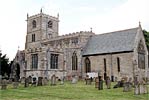For this church:    |
|
 Reredos and altar Reredos and altar |
 Reredos detail Reredos detail |
 Pelican Pelican |
In the form of three Gothic, trefoil and crocketed, geometrical arches, Bathstone with panels of Sicilian marble and red Devonshire marble pillars, with two blind arcades to each side. The three panels depict a pelican in her piety, a cross and a lamb with flag, with angels to left and right. The (retrospective) faculty for erecting the reredos is dated 4 May 1876.
Altar
 The
altar, showing the casing The
altar, showing the casing |
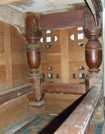 The
altar from beneath, The
altar from beneath,showing the structure |
Eighteenth Century carved oak altar table, with moulded top and stretchers and bulbous legs; encased in the late Nineteenth Century.
 Dated
Recess
Dated
Recess
The inscription:
| CHANCEL RESTORED A.D. CVIIILVII |
has been added to a medieval recess (piscina?) by the altar. The date is presumably meant to be interpreted as 1857.
Altar rails
 Altar rails Altar rails |
 Detail of wrought Detail of wroughtiron support |
Oak with wrought iron supports, probably 1857-8, but reset c1900.
Reading Desk
English oak, c1874-6.
Choir stalls
Carved and traceried, chamfered oak panels, some pierced, 1857-8, reusing some timbers from 15th century roof of chancel removed during its restoration. They were built by Henry Clipsham for £34 to general approval:
‘the new benches worked out of the oak from the old roof are a very satisfactory performance on the part of the Contractor’.
Clergy desk
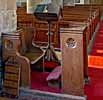 English oak, either c1874-6 or early 20th century.
English oak, either c1874-6 or early 20th century.
Pulpit
 Pulpit Pulpit |
 Detail Detail |
Ashlar, panelled, white Carrara marble with flanking red-blue Ashburton marble shafts.
The retrospective faculty for erecting the pulpit is dated 4 May 1876.
Lectern
 Plain oak with octagonal stem, 1874-5.
Plain oak with octagonal stem, 1874-5.
Font
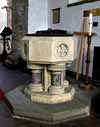 In limestone, possibly Caen, on an octagonal base, square stem with four flanking
Devonshire marble shafts, chamfered octagonal bowl with incised panels, with
oak cover decorated in wrought iron in the form of a foliate cross; the gift of
the Revd William Hutton and his wife
to mark the completion of the restoration, 1876.
In limestone, possibly Caen, on an octagonal base, square stem with four flanking
Devonshire marble shafts, chamfered octagonal bowl with incised panels, with
oak cover decorated in wrought iron in the form of a foliate cross; the gift of
the Revd William Hutton and his wife
to mark the completion of the restoration, 1876.
Christian’s plans show that it was originally to be erected at the west end of the north aisle, but a plan of 1956 shows it was then in the tower. It was moved to its present position in the south aisle in 1966.
Pews
English oak and Baltic fir, 1874-6, open seated and panelled pews. The retrospective faculty for removing earlier pews, some of which may have been box-pews, and replacing them with new ones is dated 4th May 1876. Ewan Christian’s plans show that the nave and north transept were to be entirely pewed, but the south transept was to remain empty. Pews were removed from the west end of the south aisle to provide an area for use by children in the early 1990s, and two pews were removed from the east end of that aisle when the font was moved in 1966.
Church door
English oak with wrought iron, replaced at the restoration of 1874-5, with a Woodstock lock using Barron’s levers (patented 1778); it is possible that the lock itself has been re-used (as Ewan Christian stipulated earlier fittings should be) since the key-design as well as that of the lock suggests an earlier date of installation, perhaps to coincide with the restoration of the chancel in 1857-8.
Other fittings
 Piscina
Piscina
Fourteenth century piscina in the south transept.
List of Vicars
 There is a framed panel displaying the list of incumbents to
date.
There is a framed panel displaying the list of incumbents to
date.
Panelled screen for Tower arch
English oak. A small metal plaque (17 x 15 cm), is inscribed:
| To the memory of Robert Marston, a Churchwarden of this Parish 1925 to 1967, this Screen was erected by his brother Evelyn, relatives, parishioners and friends. |
Table for Book of Remembrance
Twentieth Century oak with inscribed plaque:
| With Grateful Thanks to God For The Life of Olive Sampson 1909-2001 Who gave a Lifetime of Service to this Church Church warden 1972-1998 |
The Book of Remembrance itself bears the inscription:
| Presented by Eric and Olive Sampson 1974. |
Inscriptions on Lead
 Lead section dated 1837 Lead section dated 1837 |
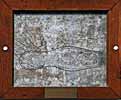 Lead section dated 1850 Lead section dated 1850 |
On the west wall of the nave, beneath the list of incumbents, within a wooden surround there is a piece of lead (73cm x 31cm), taken from the roof during repairs in 1993, with various initials and signatures (PSJ, N, S Wa...W), an alphabet in capitals, the date 1837, and the outline of a shoe.
On the wall of the base of the tower, within a wooden surround is a further piece of lead taken from the roof during repairs in 1993, with the outline of a shoe containing the words “Drury x 1850, Norwell” and also the outline of a hand.
Lost Fittings
Rood Screen
Presumably dismantled at the Reformation, but a description of the chancel before restoration in 1857 mentions a screen across the chancel arch, which was taken down and re-erected in the arch to the south transept, where it was seen by Sir Stephen Glynne before the restoration of 1874, only to be again removed and, most likely, destroyed along with other discarded timbers known to have been burned at this time. Whether the nineteenth century screen contained parts of the medieval rood screen remains an open question.
Eighteenth Century Pulpit
Installed in 1727, almost certainly constructed in wood, this pulpit had a sounding board. It did not survive the nineteenth century restorations.


